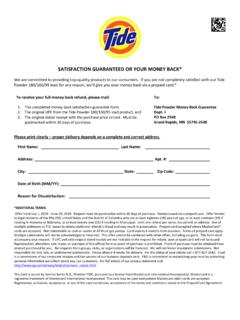Transcription of WaveGuide Height & Tide User Manual - Radac, level, tide ...
1 WaveGuide Height & Tide user Manual WaveGuide Height & Tide user Manual Applicable for product number: WG5-HT-CP. Related to software versions: wht Version 12th of Feb. 2018. Radac Elektronicaweg 16b 2628 XG Delft The Netherlands tel: +31(0)15 890 3203. e-mail: website: Preface This user Manual and technical documentation is intended for engineers and technicians involved in the software and hardware setup of the WaveGuide 5 Height and Tide System, Compact version (WG5-HT-CP). Note All connections to the instrument must be made with shielded cables. The shielding must be grounded in the cable gland or in the terminal compartment on both ends of the cable.
2 Please refer to Chapter 2 for more details regarding wiring and cable specifications. Legal aspects The mechanical and electrical installation must only be carried out by trained person- nel with knowledge of the local requirements and regulations for installation of electronic equipment. The information in this user Manual is the copyright property of Radac BV. Radac BV disclaims any responsibility for personal injury or damage to equipment caused by: Deviation from any of the prescribed procedures. Execution of activities that are not prescribed. Neglect of the general safety precautions for handling tools and use of electricity.
3 The contents, descriptions and specifications in this user Manual are subject to change without notice. Radac BV accepts no responsibility for any errors that may appear in this user Manual . Additional information Please do not hesitate to contact Radac or its representative if you require additional information. Contents Preface Introduction 1. 1 Radar positioning and installation 3. Safety notes .. 3. Positioning .. 4. Installation .. 5. 2 Wiring 6. WaveGuide radar .. 6. 3 WaveGuide system commissioning 8. Step 1. Connect the WaveGuide system to a computer .. 9.
4 Step 2. Become an authorized user .. 10. Step 3. Configuration .. 10. Step : Set system date and time .. 11. Step : Adjust network settings .. 12. Step : Sensor configuration .. 13. Step 4: Perform system check .. 15. Step : Check System Information page .. 15. Step : Check reflection diagrams .. 16. Step : Check measurements .. 16. Step 5: Configure distribution of data .. 17. 4 Using the system 19. Calculated parameters .. 19. Data logging .. 20. Appendix 1: System parameters 21. Appendix 2: System specifications 24. Introduction The WaveGuide Height & Tide is a highly accurate wave, tide and waterlevel monitoring system which is compact, robust and easy to install.
5 The WaveGuide Height & Tide consists of a WaveGuide radar, to be mounted above water level. The WaveGuide radar is a low power X-band FMCW radar that measures the distance between the water surface and the radar antenna with an accuracy of < 1 [cm]. The raw reflection signal is processed and different wave and tide parameters are calculated. The measurements and calculated parameters are stored on the system and made available to the user via a web-based interface or as a stream of UDP messages. The WaveGuide Hight & Tide is available in two versions: The Explosion proof version, where the electronics are built into an explosion proof housing.
6 The Compact version, where the antenna and electronics are built into a compact stainless steel housing. The antenna and electronics are the same in both versions but the stainless steel version is easier to handle due to its compact size. This Manual describes the Compact version of the WaveGuide 5 Direction. Please refer to the radac website for all other Manual versions. Warning Do not use the instrument for anything else than its intended purpose. This Manual consists of 4 chapters. Chapter 1 specifies the WaveGuide radar positioning criteria for optimal measurement quality.
7 Chapter 2 illustrates the mounting and installa- tion procedure. Chapter 3 describes the commissioning of the system via the user interface. Chapter 4 explains data processing, data presentation and data distribution. Please refer to Appendix 1 for a list of measured and calculated parameters. And to Appendix 2 for specifications, information about certification and environmental conditions applicable to the WaveGuide Height & Tide system. 1. Chapter 1. Radar positioning and installation Safety notes The personnel installing the WaveGuide must have basic technical skills to be able to safely install the equipment.
8 When the WaveGuide is installed in a hazardous area, the personnel must work in accordance with the local requirements for installation of electrical equipment. Caution Modification to the instrument may only be carried out by trained personnel that are authorized by Radac BV. Failure to adhere to this will invalidate the approval certificate. Warning In hazardous areas it is compulsory to use personal protection and safety gear such as: hard hat, fire-resistive overall, safety shoes, safety glasses and working gloves. Avoid possible generation of static electricity.
9 Use non-sparking tools and explosion-proof testers. Make sure no dangerous quantities of combustible gas mixtures are present in the working area. Never start working before the work permit has been signed by all parties. Warning Make sure that all power to the instrument is switched off before opening the covers of the WaveGuide radar. Failure to do so may cause danger to persons or damage the equipment. All covers of the WaveGuide radar must be closed before switching on the power. 3. Positioning For obtaining the best results from a WaveGuide Height & Tide the following radar positioning criteria must be taken into ac- count: It is advised to choose a mounting position such that the WaveGuide radar beam is free of large reflecting obstacles (the beam of the F08 antenna can be approximated to a conical shape having a 5 [deg] half top angle as shown in Fig.)
10 The minimum horizontal distance between the radar and any obstacle in the beam's path should be at least 10% of the vertical distance between the radar and the obstacle. This does not only include horizontal objects in the beam's path but also vertical structures. Any structure that the WaveGuide radar is mounted to might have some influence on the waves progressing around it. Hence, it is advised to mount the radar at a position facing the expected mean wave direction, such that the radar can measure the least disturbed water sur- face The minimum measuring distance is at 2 [m].





